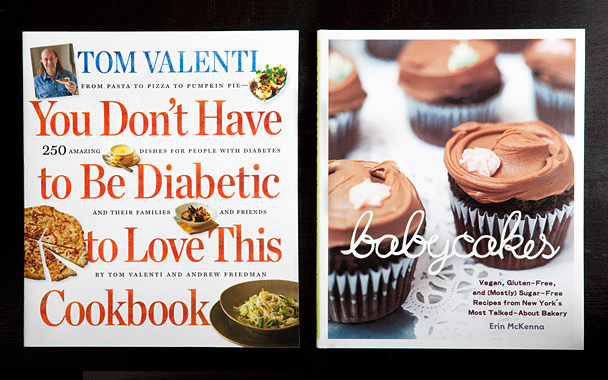I gave up refined sugar for Lent. It hasn’t been forty-days-in-the-desert hard, but it is rife with temptation. My cravings made me imagine that people with real dietary restrictions must suffer through every meal, missing out on so many good dishes. But two new cookbooks prove how wrong that assumption is. They focus on the possibilities, not the limitations, of diabetes, celiac disease, food allergies, and even voluntary veganism. Written by accomplished chefs, these books stand out in their positive approach and in the quality of their dishes.
You Don’t Have to Be Diabetic to Love This Cookbook (Workman; $32.95) may be an unfortunately lengthy title for chef Tom Valenti’s newest work, but it’s accurate. Each recipe, from Veal Meatballs en Brodo to Prosciutto-Wrapped Halibut with Asparagus and Chervil, sounds like something I want to make right this minute, and the dishes I did try were wonderful. Valenti’s recipes combine the rich, assertive flavors found at his acclaimed New York City restaurants Ouest and The West Branch with a lightness ideal for home cooking. Co-written by Andrew Friedman, Valenti’s book offers instructions and tips that ensure recipes will turn out perfectly, and it contains all the nutritional information diabetics need. By including the number of “carbohydrate choices” and “food exchanges” in each recipe, Valenti takes the guesswork out of meal planning for diabetics. And, of course, he’s designed his dishes to be low in carbohydrates and sugar, so diabetics can follow the recipes without worrying about their intake or cutting ingredients.
The book’s one downfall is, in fact, its strength. Valenti’s talent as a chef translates into recipes that are creative, delicious, and, well, cheffy. (Think blanching and white truffle oil.) The dishes are exquisite enough for any dinner party, and there’s usually a good reason behind the extra effort and ingredients. The Porcini Powder for the Creamless Creamy Mushroom Soup takes 20 minutes, but it adds a complex, savory depth.
Valenti’s candid introduction addresses diabetics but speaks to anyone who’s faced a difficult change in life. When he was diagnosed with diabetes, he experienced denial, anger, bargaining, depression, and, finally, acceptance. He writes, “There’s a common misconception out there that while diabetes is a disease that can be managed, it’s a virtual death sentence for your dining pleasure. I’d like for this book to obliterate that way of thinking.” It does—both in the thoughtful recipes and in the accompanying text. So, no, you don’t have to be diabetic to love this cookbook, but if you are, you most certainly will.
And if you have celiac disease or other food allergies, or if you follow a vegan diet, Erin McKenna’s BabyCakes (Clarkson Potter; $24.00) deserves a top slot in your cookbook collection. Like Valenti, McKenna was forced to change her diet later in life. In her case, it launched her culinary career. She started working to create sweets she could enjoy despite her wheat and dairy allergies, and the result was BabyCakes, the New York City bakery she opened in 2005. Over the years, it has gained a passionate following of health-conscious Hollywood types (she plans to open an L.A. branch in the near future) and moms desperate to give their dairy-and-egg-intolerant kids their first cookie. The bakery has also received rave reviews in national food publications.
In another article for gourmet.com, Rebecca Marx describes the success of these types of sweets: “In a weird way, vegan desserts are like the pastry world’s version of breast implants: The best ones are indistinguishable from their conventional counterparts.” That’s not entirely true for McKenna’s desserts; just as white flour, butter, sugar, and eggs bake into distinct flavors and textures, so do spelt, coconut oil, and agave nectar. To put it judiciously, they’re different. Even if you have no dietary restrictions, you may prefer McKenna’s baked goods for their complex earthiness. They’re undeniably good and arguably similar to the real thing, but cooking from her book results in treats with a more pronounced vegan flair.
It could be because the recipes lack the details that the best baking manuals include. With each recipe (and without vegan baking experience), I wondered, “Did I buy the right rice milk? Should the coconut oil be measured in its solid or liquid form? If liquid, how should I melt it? How long should I be whisking? What should this batter look like?” I breathed a sigh of relief when the Spelt Biscuits came out golden and flaky, the Gingersnaps crisp and spicy, the Vanilla Cupcakes moist and tender. But as I stirred the Vanilla Frosting into what looked—and smelled—like wet cement, I couldn’t figure out where I’d gone wrong. Should I have used sweetened instead of unsweetened soy milk? Although the “sources” section offers a few recommendations for specific brands, I wish there were more.
For the most part, though, the recipes worked beautifully. The muffins, cookies, and pies were not exactly like standard versions, but they wowed tasters with nuanced flavors and rich textures that were more cutting-edge-pastry-chef than hippy-dippy-vegan. I didn’t feel like I was missing a thing, and I learned about ingredients I’d never tried before. Nothing called for refined sugar, so technically, I never broke my Lenten fast. But eating these indulgent sweets, it already felt like Easter.



 Pinterest
Pinterest


